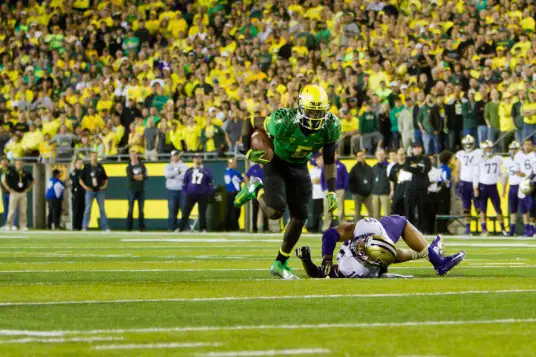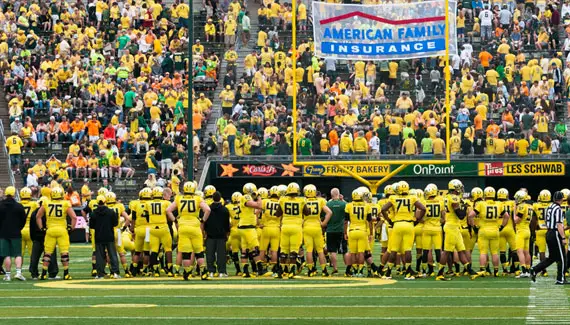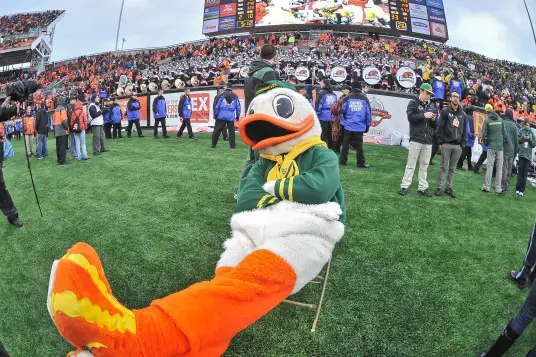Much like recruiting has its dead periods, college football news has its dead periods – and between post-regular season and pre-bowl games, is one of its quietest. Oregon fans may not have noticed in recent years, as their presence in BCS bowls has led to plenty of words being written about their team leading up to those marquee games, but with the Ducks playing before New Year’s Day for the first time in a half-decade, Oregon fans are remembering what most college football fans have experienced for a while: There aren’t a whole lot of stories written during the two weeks between the regular season and bowl season.
Yet, there were two articles from last week, one on Oregon’s monetary value, and the other on how they can increase it.
The first of those articles is one of the more intriguing articles written annually on the business side of college football: The annual valuation of college football programs, as done by Forbes. Of course, that article wouldn’t be mentioned here if it didn’t feature Oregon in some way. Either as No. 5 best-vaule team or No. 19 as the most-valuable team.

Players such as De’Anthony Thomas help Oregon keep pace with the top Pac-12 schools in program value.
Some highlights of the article:
- Forbes determined the most valuable teams in college football (only the top 20 most-valuable programs were mentioned), along with the best and worst values for the money (top and bottom five by costs per win). Oregon was the only team on both the “Most Valuable” and “Best Value” list, while Auburn was the only team to make both the “Most Valuable” and “Worst Value” list. Yes, Auburn’s national championship was factored into the study.
- Oregon football was valued at $64 million by Forbes, making them the 19th most-valuable team in college football. The Ducks spent $59.5 million in football-related expenses over the three years of the study (2010-11 to 2012-13), spending just under $1.9 million per win, the fifth-best value in college football over that time.
- Despite being the only team in college football on both the “Most Valuable” and the “Best Value” lists, it doesn’t lead the Pac-12 in either category. Stanford was a better value than Oregon over those three years at just under $1.7 million per win, good for third in the nation over that span (*shakes fist towards Palo Alto*). Meanwhile, Oregon is third in the Pac-12 in overall value, behind USC (13th nationally at $73 milion) and Washington (17th, $66 million.)
It is the rivalry with that second team that will facilitate’s Oregon’s quest to increase its value.
What gives Washington the edge? The Huskies are valued at only $2 million more than the Ducks, the same difference in the amount of revenue each program brought in last year, meaning that the programs likely would be valued identically if not for the disparity in annual revenue. This means that to make up the difference, Oregon will have to find some way to close the revenue gap. In order to increase annual revenue, it appears Oregon has one of two options:
1) Increase the Size of Autzen Stadium
According to the Forbes article, the increase in Oregon’s value was attributed to “the Ducks’ revenue [being] up $2 million thanks in large part to increased ticket prices, [d]espite hosting one fewer home game than the previous season [2011 vs. 2012].”
Given that the University of Oregon struggled to sell out multiple home games this season, even prior to its late-season struggles, it would appear that the team is already operating at the peak of market elasticity with regards to pricing. While they managed to sell out those games, and every game for the past 14 years (the Huskies cannot say the same), Autzen Stadium still has a lower average attendance per game than Washington, while playing in a stadium that has a capacity of 16,000 fewer seats.
It is perfectly understandable and well-measured for the athletic department to take a wait-and-see approach to stadium expansion; attendance is down all over college football. Despite having nine bowl eligible teams in 2013, the Pac-12 saw a decrease in average attendance, a year after it was the only AQ conference in college football to see an increase (the increase was largely attributable to Cal moving into a larger venue). Smaller stadiums create scarcity, and scarcity creates demand. On the other hand, seats that don’t exist generate zero revenue, and adding seating is one of the most direct ways to increase revenues.
Should they decide against stadium expansion in the future, there is one other option:
2) Get a Live Duck For a Mascot
The second of the previously mentioned notable articles from last week came from Deadspin last Friday, which determined the financial impact those schools with live mascots experienced. They found that “on average, an AQ member school with a live animal mascot generates about $8.5 million in incremental revenue!“ An increase of even half that amount would make Oregon the highest earning team in the Pac-12.
The Oregon Ducks have not had anything resembling a live mascot since 1947, when the school discontinued the practice of students capturing live ducks around campus to bring to games to serve as a “mascot,” after pressure from the Humane Society and those in the community to discouraged the practice.
However, things have changed significantly with regards to caring for animals in the last 66 years, and a live duck wouldn’t spell an end for The Duck, either. Plenty of schools have mascots of the live and costumed variety: LSU, Texas, and Colorado, just to name a few. Much the same way LSU puts Mike, their live tiger, right by the opponent’s entrance, Oregon could intimidate its opponent by putting its fearsome live mascot on the east end of the Autzen end zone as the players come on the field. Or they could build a moat ringing the field that so the live duck can swim around and intimidate opposing players from all angles.
Whichever route the Ducks should choose to go, they still need to keep up. The study measured Oregon against Washington during the era of “Seven-Win Steve” Sarkisian. With Washington’s fanbase energized following the hire of Chris Petersen, the arms race is sure to continue. It will be interesting to see what Oregon does to keep pace.
Top Photo by Craig Strobeck
Related Articles:
Nathan Roholt is a senior writer and managing editor emeritus for FishDuck. Follow him on Twitter @nathanroholt. Send questions/feedback/hatemail to nroholtfd@gmail.com.



